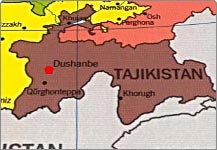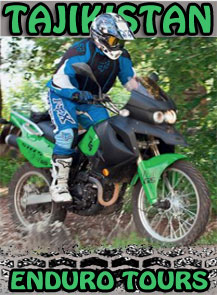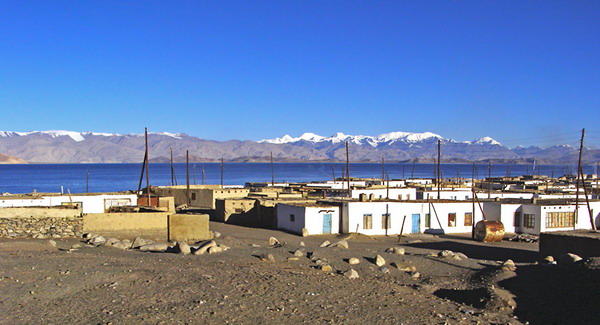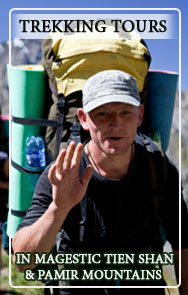Tajikistan country facts
Cities | Weather | Getting in&out | Customs | Getting around | Money Communication | Safety | Healthcare | Food&drink | Festivals | Maps
Source: www.cia.gov
Tajikistan | |
Background: | The Tajik people came under Russian rule in the 1860s and 1870s, but Russia's hold on Central Asia weakened following the Revolution of 1917. Bolshevik control of the area was fiercely contested and not fully reestablished until 1925. Tajikistan became independent in 1991 following the breakup of the Soviet Union, and it is now in the process of strengthening its democracy and transitioning to a free market economy after its 1992-1997 civil war. There have been no major security incidents in recent years, although the country remains the poorest in the former Soviet sphere. Attention by the international community in the wake of the war in Afghanistan has brought increased economic development assistance, which could create jobs and increase stability in the long term. Tajikistan is in the early stages of seeking World Trade Organization membership and has joined NATO's Partnership for Peace. |
Geography | Tajikistan |
Location: | Central Asia, west of China |
Geographic coordinates: | 39 00 N, 71 00 E |
Map references: | Asia |
Area: | total: 143,100 sq km |
Area - comparative: | slightly smaller than Wisconsin |
Land boundaries: | total: 3,651 km |
Coastline: | 0 km (landlocked) |
Climate: | midlatitude continental, hot summers, mild winters; semiarid to polar in Pamir Mountains |
Terrain: | Pamir and Alay Mountains dominate landscape; western Fergana Valley in north, Kofarnihon and Vakhsh Valleys in southwest |
Elevation extremes: | lowest point: Syr Darya (Sirdaryo) 300 m |
Natural resources: | hydropower, some petroleum, uranium, mercury, brown coal, lead, zinc, antimony, tungsten, silver, gold |
Land use: | arable land: 6.52% |
Irrigated land: | 7,220 sq km (2003) |
Environment - international agreements: | party to: Biodiversity, Climate Change, Desertification, Environmental Modification, Ozone Layer Protection, Wetlands |
Geography - note: | landlocked; mountainous region dominated by the Trans-Alay Range in the north and the Pamirs in the southeast; highest point, Qullai Ismoili Somoni (formerly Communism Peak), was the tallest mountain in the former USSR |
Population: | 7,349,145 (July 2009 est.) |
Age structure: | 0-14 years: 34.3% (male 1,282,681/female 1,238,607) |
Median age: | total: 21.9 years |
Population growth rate: | 1.878% (2009 est.) |
Birth rate: | 26.9 births/1,000 population (2009 est.) |
Death rate: | 6.83 deaths/1,000 population (July 2009 est.) |
Net migration rate: | -1.28 migrant(s)/1,000 population (2009 est.) |
Sex ratio: | at birth: 1.05 male(s)/female |
Infant mortality rate: | Total: 41.03 deaths/1,000 live births |
Life expectancy at birth: | total population: 65.33 years |
Total fertility rate: | 2.99 children born/woman (2009 est.) |
Nationality: | noun: Tajikistani(s) |
Ethnic groups: | Tajik 79.9%, Uzbek 15.3%, Russian 1.1%, Kyrgyz 1.1%, other 2.6% (2000 census) |
Religions: | Sunni Muslim 85%, Shia Muslim 5%, other 10% (2003 est.) |
Languages: | Tajik (official), Russian widely used in government and business |
Literacy: | definition: age 15 and over can read and write |
Country name: | conventional long form: Republic of Tajikistan |
Government type: | republic |
Capital: | name: Dushanbe |
Administrative divisions: | 2 provinces (viloyatho, singular - viloyat) and 1 autonomous province* (viloyati mukhtor); Viloyati Khatlon (Qurghonteppa), Viloyati Mukhtori Kuhistoni Badakhshon* [Gorno-Badakhshan] (Khorugh), Viloyati Sughd (Khujand) |
Independence: | 9 September 1991 (from Soviet Union) |
National holiday: | Independence Day (or National Day), 9 September (1991) |
Constitution: | 6 November 1994 |
Legal system: | based on civil law system; no judicial review of legislative acts; has not accepted compulsory ICJ jurisdiction |
Suffrage: | 18 years of age; universal |
Executive branch: | chief of state: President Emomali RAHMONOV (since 6 November 1994; head of state and Supreme Assembly chairman since 19 November 1992) |
Legislative branch: | bicameral Supreme Assembly or Majlisi Oli consists of the National Assembly (upper chamber) or Majlisi Milliy (34 seats; 25 members selected by local deputies, 8 appointed by the president; 1 seat reserved for the former president; to serve five-year terms) and the Assembly of Representatives (lower chamber) or Majlisi Namoyandagon (63 seats; members are elected by popular vote to serve five-year terms) |
Judicial branch: | Supreme Court (judges are appointed by the president) |
Political parties and leaders: | Agrarian Party of Tajikistan or APT [Amir KARAKULOV]; Democratic Party or DPT [Mahmadruzi ISKANDAROV (imprisoned October 2005)]; Islamic Revival Party [Muhiddin KABIRI]; Party of Economic Reform or PER [Olimjon BOBOYEV]; People's Democratic Party of Tajikistan or PDPT [Emomali RAHMONOV]; Social Democratic Party or SDPT [Rahmatullo ZOYIROV]; Socialist Party or SPT [Abdualim GHAFFOROV]; Tajik Communist Party or CPT [Shodi SHABDOLOV] |
Political pressure groups and leaders: | splinter parties recognized by the government but not by the base of the party: Democratic Party or DPT [Masud SOBIROV] (splintered from ISKANDAROV's DPT); Socialist Party or SPT [Abduhalim GHAFFOROV] (splintered from NARZIEV's SPT) |
International organization participation: | ADB, CIS, CSTO, EAEC, EAPC, EBRD, ECO, FAO, GCTU, IAEA, IBRD, ICAO, ICCt, ICRM, IDA, IDB, IFAD, IFC, IFRCS, ILO, IMF, Interpol, IOC, IOM, IPU, ISO (correspondent), ITSO, ITU, MIGA, NAM (observer), OIC, OPCW, OSCE, PFP, SCO, UN, UNCTAD, UNESCO, UNIDO, UNWTO, UPU, WCO, WFTU, WHO, WIPO, WMO, WTO (observer) |
Flag description: | three horizontal stripes of red (top), a wider stripe of white, and green; a gold crown surmounted by seven gold, five-pointed stars is located in the center of the white stripe |
Economy - overview: | Tajikistan has one of the lowest per capita GDPs among the 15 former Soviet republics. Because of a lack of employment opportunities in Tajikistan, nearly half of the labor force works abroad, primarily in Russia, supporting families in Tajikistan through remittances. The exact number of labor migrants is unknown, but estimated at around 1 million. Less than 7% of the land area is arable. Cotton is the most important crop, but this sector is burdened with debt and obsolete infrastructure. Mineral resources include silver, gold, uranium, and tungsten. Industry consists only of a large aluminum plant, hydropower facilities, and small obsolete factories mostly in light industry and food processing. The civil war (1992-97) severely damaged the already weak economic infrastructure and caused a sharp decline in industrial and agricultural production. Tajikistan's economic situation remains fragile due to uneven implementation of structural reforms, corruption, weak governance, widespread unemployment, seasonal power shortages, and the external debt burden. A debt restructuring agreement was reached with Russia in December 2002 including a $250 million write-off of Tajikistan's $300 million debt. Completion of the Sangtuda I hydropower dam - built with Russian investment - and the Sangtuda II and Rogun dams will add substantially to electricity output. If finished according to Tajik plans, Rogun will be the world's tallest dam. Tajikistan has also received substantial infrastructure development loans from the Chinese government to improve roads and an electricity transmission network. To help increase north-south trade, the US funded a $36 million bridge which opened in August 2007 and links Tajikistan and Afghanistan. While, Tajikistan has experienced steady economic growth since 1997, nearly two-thirds of the population continues to live in poverty. Economic growth reached 10.6% in 2004, but dropped below 8% in 2005-08, as the effects of higher oil prices and then the international financial crisis began to register - mainly in the form of lower prices for key commodities and lower remittances from Tajiks working in Russia, due to the declining economic conditions in that country. |
GDP: | $5.135 billion (2008 est.) |
GDP - real growth rate: | 7.9% (2007 est.) |
GDP - per capita: | $1,300 (2006 est.) |
GDP - composition by sector: | agriculture: 22.7% |
Investment (gross fixed): | 12% of GDP(2008 est.) |
Population below poverty line: | 60% (2007 est.) |
Household income or consumption by percentage share: | lowest 10%: 3.3% |
Distribution of family income - Gini index: | 32.6 (2006) |
Inflation rate (consumer prices): | 20.5% (2008 est.) |
Labor force: | 2.1 million (2008) |
Labor force - by occupation: | agriculture: 67.2% |
Unemployment rate: | 2.3% (2008 est.) |
Budget: | revenues: $996.8 million |
Agriculture - products: | cotton, grain, fruits, grapes, vegetables; cattle, sheep, goats |
Industries: | aluminum, zinc, lead; chemicals and fertilizers, cement, vegetable oil, metal-cutting machine tools, refrigerators and freezers |
Industrial production growth rate: | -4% (2008 est.) |
Electricity - production: | 17.3 billion kWh (2008) |
Electricity - consumption: | 17.8 billion kWh (2008) |
Electricity - exports: | 1 billion kWh (2008) |
Electricity - imports: | 4.361 billion kWh (2008) |
Oil - production: | 238 bbl/day (2008 est.) |
Oil - consumption: | 36,000 bbl/day (2008 est.) |
Oil - exports: | 348.9 bbl/day |
Oil - imports: | 10,100 bbl/day (2008) |
Oil - proved reserves: | 12 million bbl (1 January 2009 est.) |
Natural gas - production: | 15.3 million cu m (2008 est.) |
Natural gas - consumption: | 515.3 billion cu m (2004 est.) |
Natural gas - exports: | 0 cu m (2004 est.) |
Natural gas - imports: | 500 billion cu m (2008 est.) |
Natural gas - proved reserves: | 5.663 billion cu m (1 January 2009 est.) |
Current account balance: | $47.6 million (2008 est.) |
Exports: | $1.575 billion (2008 est.) |
Exports - commodities: | aluminum, electricity, cotton, fruits, vegetable oil, textiles |
Exports - partners: | Netherlands 36.7%, Turkey 26.5%, Russia 8.6%, Iran 6.6%, China 5.7%, Uzbekistan 5.1% (2008) |
Imports: | $3.699 billion (2008 est.) |
Imports - commodities: | electricity, petroleum products, aluminum oxide, machinery and equipment, foodstuffs |
Imports - partners: | Russia 32.3%, China 11.9%, Kazakhstan 8.8%, Uzbekistan 4.7% (2008) |
Reserves of foreign exchange & gold: | $195 million (31 December 2008 est.) |
Debt - external: | $1.503 billion (31 December 2008 est.) |
Currency: | somoni |
Currency code: | TJS |
Exchange rates: | Tajikistani somoni (TJS) per US dollar - 3.4563 (2008 est.), 3.4418 (2007), 3.3 (2006), 3.1166 (2005), 2.9705 (2004) |
Fiscal year: | calendar year |
Telephones - main lines in use: | 360.000 (2008) |
Telephones - mobile cellular: | 3.5 million (2009) |
Telephone system: | general assessment: foreign investment in the telephone system has resulted in major improvements |
Radio broadcast stations: | 16 (number of licensed stations with only about 10 broadcasting) (2009) |
Television broadcast stations: | 24 (number of licensed stations with only about 15 active) (2009) |
Internet country code: | .tj |
Internet hosts: | 987 (2009) |
Internet users: | 600,000 (2008) |
Railways: | total: 680 km |
Roadways: | total: 27,767 km (2000) |
Waterways: | 200 km (along Vakhsh River) (2008) |
Pipelines: | gas 549 km; oil 38 km (2008) |
Airports: | 26 (2009) |
Airports - with paved runways: | total: 18 |
Airports - with unpaved runways: | total: 8 |
Military branches: | Ground Troops, Air and Air Defense Troops, Mobile Troops (2008) |
Military manpower - military age and obligation: | 18 years of age for compulsory military service; conscript service obligation - two years (2009) |
Military manpower - availability: | males age 16-49: 1,897,356 |
Military manpower - fit for military service: | males age 16-49: 1,428,218 |
Military manpower - reaching military age annually: | male: 80,819 |
Military expenditures - percent of GDP: | 3.9% of GDP |
Transnational Issues | |
Disputes - international: | in 2006, China and Tajikistan pledged to commence demarcation of the revised boundary agreed to in the delimitation of 2002; talks continue with Uzbekistan to delimit border and remove minefields; disputes in Isfara Valley delay delimitation with Kyrgyzstan |
This page was last updated on 20 Jan, 2010
Home | Travel Basics | Tours | Visa&Formalities | Must See | FAQ's | About us





 Little Pamir 22 day
Little Pamir 22 day




